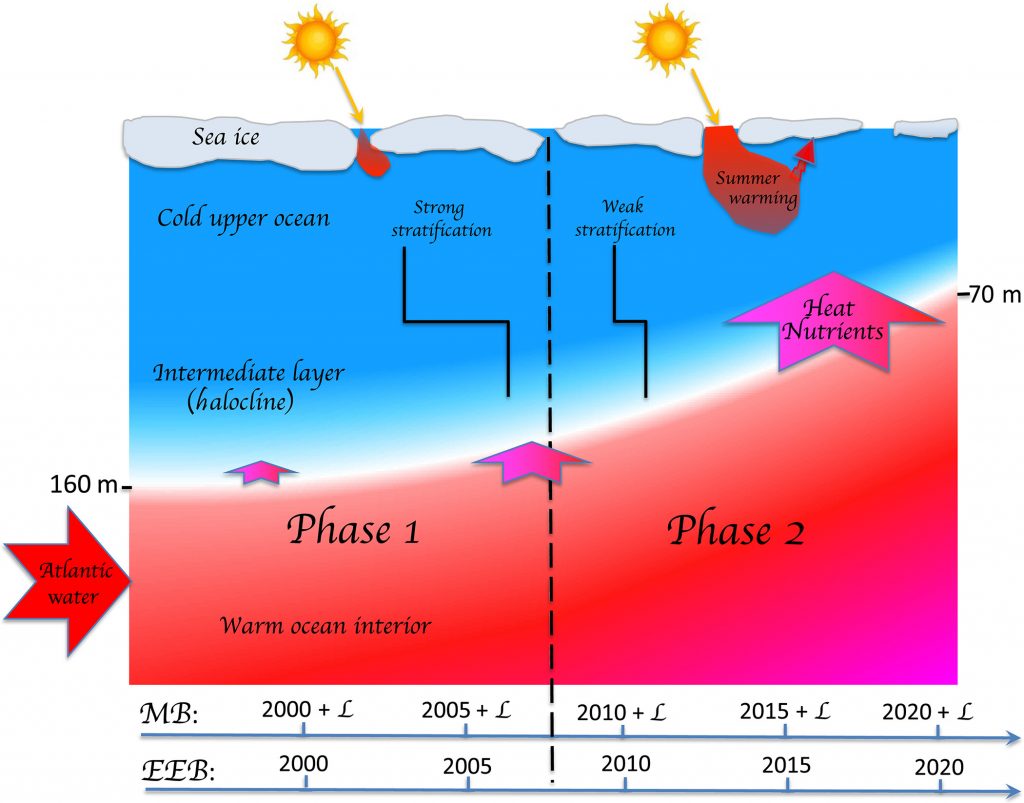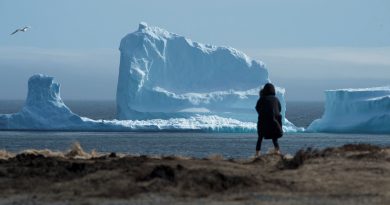Atlantification ushering in new era of sea ice loss in the Siberian Arctic

Warm Atlantic waters are rapidly reshaping the Siberian Arctic, sparking an era of unprecedented sea ice loss—something that will have ongoing implications for the region’s ecosystem and climate, says new research.
The study, published in the journal Science Advances, found that his process—known as atlantification—is melting sea ice faster than ever before as it pushes further into the Arctic Ocean near Russia.
“The eastern part of the Siberian Arctic Ocean is still strongly stratified, but the atlantification-driven shoaling of warm, salty, and nutrient-rich intermediate waters already has important ecological consequences there,” the authors on the international research team said in the study.
To do the study, the researchers combined mooring data and satellite observations to track ocean temperatures and salinity at different depths. They focused on the warm water coming in from the Atlantic and how much heat it was delivering to—and melting—the sea ice. They also examined how the layers of water in the ocean were shifting and what that meant for ice thickness.
“In particular, we show that the winter ventilation of the halocline in the eastern Eurasian Basin resulted in more than twofold rate in sea-ice loss caused by oceanic heat fluxes as compared to the 2010s,” the paper said.
Phenomenon is accelerating
The movement of warm, salty Atlantic waters into the Arctic has been occurring since the 1970s, but has accelerated in recent decades.
- Weakening ocean layers: Warm Atlantic water mixing with the colder Arctic waters weakens the boundary between them, affecting the ocean layers’ stability.
- Faster ice melt: As more warm water flows into the Arctic, sea ice is melting quicker, especially in the winter. With less surface ice to reflect sunlight, the dark water and ground absorbs more heat which in turn speeds up ice melt even more.
- More nutrients at the water’s surfacer: Warm Atlantic waters bring nutrients from deeper down in the ocean to the surface. This means marine life will have more nutrients feed off of, affecting the Arctic food chain and how it functions.
The study found that one key factor driving this acceleration is the weakening barrier between the ice-covered surface of the Arctic Ocean and the warmer ocean waters below.
As the sea ice continues to thin, it makes it easier for these warmer waters to flow deeper into the ocean, speeding up the melting process.

“The powerful ocean-heat/ice-albedo feedback mechanism is the primary cause of these changes,” the researchers said.
“Deep ventilation and weak stratification increase upward [Atlantic Water] heat fluxes, which promotes the wintertime suppression of sea-ice formation and subsequent more effective summertime reduction of sea ice by an ice-albedo feedback.
“This complex process was the key to establishing the diminished sea-ice cover in the Siberian Arctic in recent years.”
- Eurasian Basin The main area the study focuses on, where warm Atlantic waters are pushing deeper into the Arctic and melting sea ice faster.
- East Siberian Sea: This region is also feeling the effects of warmer waters from the Atlantic, speeding up ice melt and impacting the ecosystem.
- Chukchi Sea: Warm Atlantic waters are reaching this area as well, contributing to the changes happening across the Arctic.
Researchers say further studies are needed to better understand the full scope of these changes and their implications. Tracking how ocean waters, ice, and ecosystems continue to change will help scientists predict future shifts and shape climate policies, they said.
“The eastern part of the Siberian Arctic Ocean is still strongly stratified, but the atlantification-driven shoaling of warm, salty, and nutrient-rich intermediate waters already has important ecological consequences there,” the study said.
“Disentangling the role of atlantification in multiple and complex high-latitude changes should be a priority in future modeling and observational efforts.”
Comments, tips or story ideas? Contact Eilís at eilis.quinn(at)cbc.ca
Related stories from around the North:
Canada: Arctic ice shift: Melting multiyear floes trigger decline in vital pressure ridges, CBC News
Norway: Thawing permafrost melts ground under homes and around Global Seed Vault in Svalbard, The Independent Barents Observer
Russia: Melting permafrost may release industrial pollutants at Arctic sites: study, Eye on the Arctic
United States: 30–50% of critical northern infrastructure could be at high risk by 2050 due to warming, says study, Eye on the Arctic



